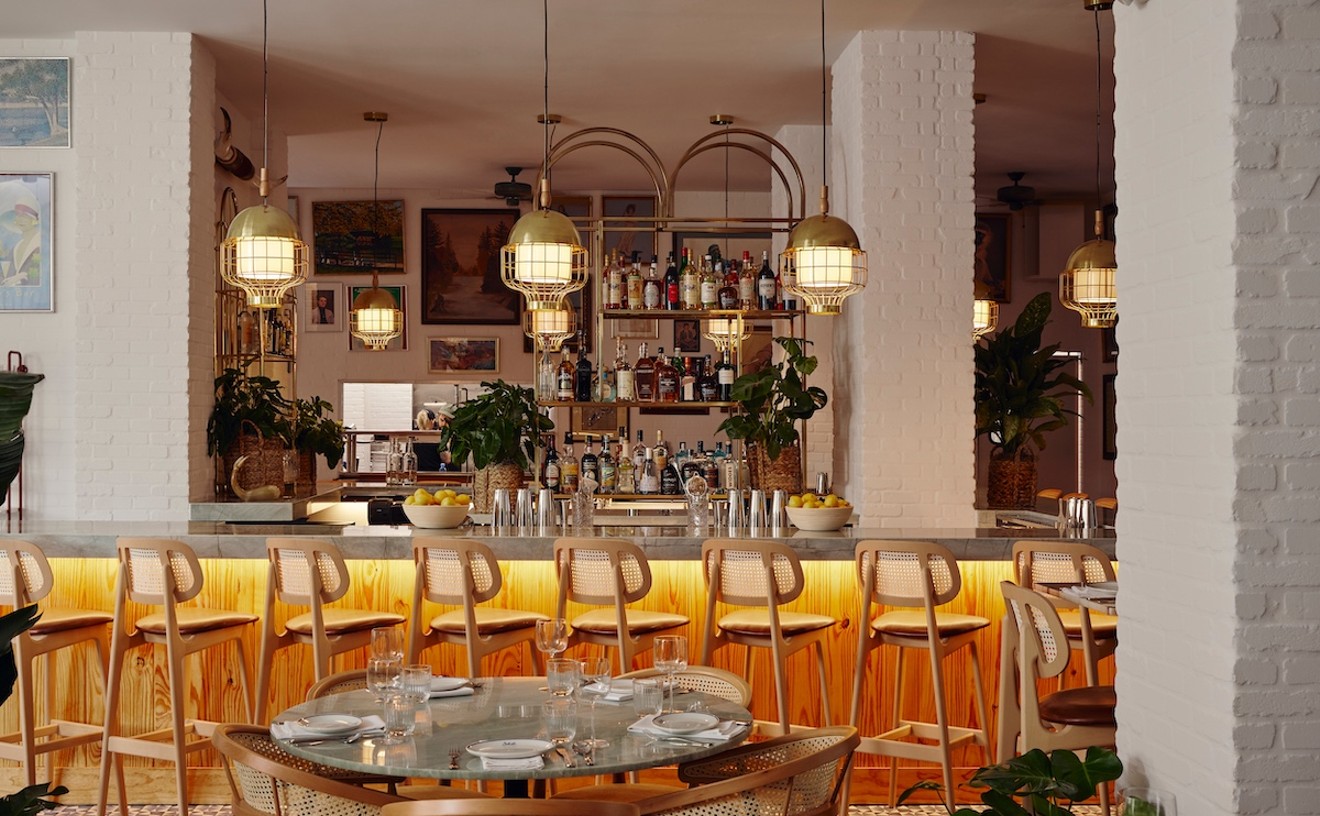If Putin's handling of the Kursk incident seemed a throwback to the bad old days of the U.S.S.R., so is the food and décor at Vecherny Vostok -- only in this case that's good. The dark lighting, low ceilings, red-muraled and mirrored walls, and tacky disco dance floor conspire to make you feel as though you're really in a Russian restaurant. The place looks downright Siberian on weeknights, when the cavernous 100-seat space is mostly empty. But come late Saturday evening, it plugs in: Volume of music (live) and talk (lively and Slavic) goes up, shots of chilled vodka go down, there's dancing and dining and everyone doing what Russians do best -- joining the party. Sometimes till about 5:00 a.m.
This is not Red Square -- no blinis with crme fraîche and caviar (and almost nothing costs more than $10). This isn't the Rascal House, either -- not a blintz in sight. And those weaned on bottles of Manischewitz borscht will find the more-beef-than-beet Ukrainian version here unrecognizable. They will, however, most likely enjoy it, chock full as it is of peas, potatoes, onions, carrots, celery, chunks of meat, fresh dill, and cilantro (along with bits of beets). Another superb soup contained numerous won-ton-wrapped ground lamb dumplings (pelmeny) in a deeply flavored, dill-flecked chicken broth. Lepioshka bread from Buchara makes a great sop, the chewy dough a cross between soft pretzel and bialy, but it must be ordered separately.
The clientele and staff are Russian to the core. The waiter, as a matter of fact, didn't speak much English and seemed taken aback when we did. He was able, though, to inform us that an “olivie” salad had nothing to do with the small oval fruit. It was, as he described it, “Russian, but really it's French”-- referring, no doubt, to the mayonnaise sauce, which binds diced boiled potatoes, eggs, and onions. Dolmas, four stumps of stuffed grape leaves, were different from the Greek variety. The leaves aren't marinated in vinegar, and rather than being filled mostly with rice, these contain just a little of that grain and a whole lot of highly seasoned ground lamb. They tasted like lamb sausages and were delicious. Piroghi, though, were subpar, not just because we wanted potato filling (“We are out of potatoes” glumly confided our waiter) but the browned pastry casing of the substitute meat version contained grisly diced beef inside. The lack of tubers also dashed any hopes of herring with potatoes, so we ordered “red caviar,” those orange globular salmon eggs. This pleased others at the table, but my dad used to employ these as fish bait, an association that still dampens my enthusiasm for them. Instead I saved my appetite for beef stroganoff, but I needn't have; it was an unexpectedly light treatment, bereft of cream or sauce. More like a beef stir-fry really, accompanied by French fries (not, I suppose, technically potatoes) and slices of tomato and cucumber.
Owing to a language barrier, the lamb shish kebab we ordered somehow translated into a fresh rectangle of skewered sautéed salmon, with a lemon wedge for simple citric sparkle. On a return visit, we managed to get the right kebab, an appetizer portion of six grilled cubes of savory lamb. Karl Marx would've appreciated Vecherny's proletarian prices: Many starters, like the kebabs, cost just $3.50; main courses range from $8.50 to $12.50.
Mi Bosquecito is smaller and nicer than Vecherny, but the food isn't as impressive overall. At least not that which was available: They were out of three of five nonsoup appetizers, including the only two arepas (chorizo and chicharrón). A Colombian restaurant sans arepas is even more bizarre than a Russian place without potatoes. Even worse, no bread at all, and our soup didn't come until twenty minutes after we ordered. The sopa campesina (“country soup”), when it did come, contained a chicken thigh on the bone, tender cubes of beef, and a plethora of vegetables. It's hard to imagine a stock containing all those ingredients being bland, but it was.
Appetizers arrived just minutes after the soup. Shrimp ceviche was certainly unique, the crustaceans doused with diced onions and a cilantro-heavy tomato sauce aromatic of ketchup; it was better than it sounds. And better than the picada, a platter of small, dry pieces of beef, squares of salted pork belly, slices of plantains, chunks of chorizo, and wedges of undressed tomato. Main courses were served along with the starters (we were still eating our soup), and just like that our table became a buffet. Bandeja paisa, a Colombian national dish cooked up by the Spanish segment of the populace, is presented here as a sort of poor man's parillada, a platter (bandeja) plumped with a baconlike slab of pork belly, a thin, tough disk of beef, more dried chunks of meat, and two whole chorizos. A dome-shape mound of white rice topped with fried egg and large red beans makes this a filling, if not completely satisfying, meal. Arepas were supposed to be included, but ...
Sobrebarriga a la criolla is the stomach of beef, a cut and treatment similar to braised brisket. The soft, flavorful flank was topped with diced onions and tomatoes in a thin beef jus, with two boiled potato chunks on the side; main courses also come with plantain spears. A long strip of churrasco steak, is, at $10.95, the most expensive menu item. It's also the most popular, and perhaps the best. Another savvy pick would be crisply breaded pork cutlet with ham and melted cheese in the center. Snapper is available five ways, chicken six, and a few pastas are offered, such as fettuccine Alfredo and spaghetti and meatballs. Good Colombian beer, Aguila, too.
If you order the right dishes, and if they have them, Mi Bosquecito is a decent, inexpensive eatery, certainly worth checking out if you live in the area. Vecherny Vostok, though, is a real find, and easily makes my Top 20 list of best ethnic restaurants in Miami. Make that Top 20 with a bullet.











